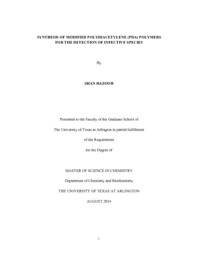
ATTENTION: The works hosted here are being migrated to a new repository that will consolidate resources, improve discoverability, and better show UTA's research impact on the global community. We will update authors as the migration progresses. Please see MavMatrix for more information.
Show simple item record
| dc.contributor.advisor | Foss, Frank W | |
| dc.contributor.advisor | Foss, Frank W | |
| dc.creator | Hazoor, Shan | |
| dc.date.accessioned | 2022-01-20T17:34:03Z | |
| dc.date.available | 2022-01-20T17:34:03Z | |
| dc.date.created | 2019-08 | |
| dc.date.issued | 2019-08-09 | |
| dc.date.submitted | August 2019 | |
| dc.identifier.uri | http://hdl.handle.net/10106/30142 | |
| dc.description.abstract | Polydiacetylene (PDAs) polymers are receiving more attention as biosensors due to their ability to change absorption and fluorescence properties upon sensing various chemical and physical changes in the environment. In chapter 1, the introduction to PDA polymers have been described along with their optical properties. Diacetylene (DA) monomers can be synthesized to tune photochemical and sensing properties of PDAs. DAs self-polymerize upon UV-irradiation and show fluorescence upon stimulation. They have been reported as biological and chemical sensors, capable of visible color changes (e.g. blue to red) upon certain environmental factors such as temperature, pH changes, and upon binding with biological species or other analytes. Chapter 2 discussed two important previously published studies of PDA material as biosensors. it is reviewed that PDA modified with different receptors and substrates were able to detect target biological species. In Chapter 3 we have described our interest and approach for PDA polymers synthesis using 2 different antibiotics and a sialic acid. In chapter 4 we described the synthesis of new derivatives of 10,12-pentacosadiyonic acid (PCDA) that are coupled to different biological inhibitors such as vancomycin, sialic acid, and polymixin B. Following literature, in chapter 5 we observed the PDA binds to specific metals as well from their color change property. So far we have successfully coupled vancomycin with PCDA and are in a process of investigating its function as a detector and inhibitor for gram positive bacteria Staphylococcus aureus (S. aureus). Additionally, various diamine linkers will be investigated to optimize PDA-inhibitor linkage and function. The completed PDAs are processed into liposomes, which bind to specific classes of bacteria or viruses, potentially inhibit their growth, and give an identifying fluorescence signal to indicate the presence of infection. | |
| dc.format.mimetype | application/pdf | |
| dc.language.iso | en_US | |
| dc.subject | Polymerization | |
| dc.subject | Polydiacetylenes | |
| dc.subject | Biosensors | |
| dc.subject | Colorimetry | |
| dc.title | Synthesis of modified polydiacetylene (PDA) polymers for the detection of infective species | |
| dc.type | Thesis | |
| dc.degree.department | Chemistry and Biochemistry | |
| dc.degree.name | Master of Science in Chemistry | |
| dc.date.updated | 2022-01-20T17:34:03Z | |
| thesis.degree.department | Chemistry and Biochemistry | |
| thesis.degree.grantor | The University of Texas at Arlington | |
| thesis.degree.level | Masters | |
| thesis.degree.name | Master of Science in Chemistry | |
| dc.type.material | text | |
| dc.creator.orcid | 0000-0002-9777-8876 | |
Files in this item
- Name:
- HAZOOR-THESIS-2019.pdf
- Size:
- 10.91Mb
- Format:
- PDF
This item appears in the following Collection(s)
Show simple item record


